Uncovering the contextual bias in AI: You still need your camera for realistic African images

One of the oft-touted challenges of AI is context. Another is bias. AI applications cannot simply be copied and pasted into different contexts say from Western nations to Asian ones as the AI models need training for situational awareness. Nowhere is this challenge of AI more apparent than in the African continent which has 54 countries with two disputed areas, over 1,000 languages and wildly diverse cultures. This is not just a problem particular to AI. Even movies which aim to portray the African continent will struggle with this problem. Take the film ‘Black Panther’ which portrays ‘Wakanda’ as a fictional technologically advanced African nation. It relied heavily on southern african dressing and accents to represent a country in the continent.
As a canva-level amateur designer, I was excited to explore the text-to-image offerings of AI. I explored various AI applications online and quickly ran into its challenges which I will seek to illustrate in this article. I admit that proper prompting can help generate better AI images but even with multiple prompts, AI still struggles with bias. Infact, AI has often been accused of racism. Again, one has to take cognisance that this is due to the available data sets and the training of the model. Take the image below and the accompanying prompt.
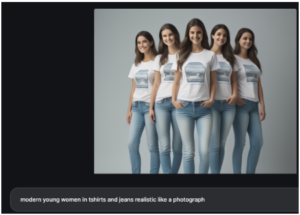
The bias of this application is clear in that it generated women who look like quintuplets, same colour hair, same clothing and even pose. Still, the application took the general category ‘modern women’ to represent all white women. When prompted further, it produced triplets, and assumed they too would want to be dressed similarly and sport the same hairstyle.
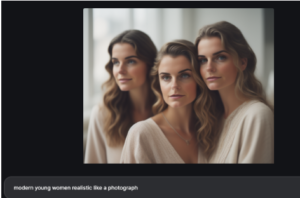
I had to prompt ‘African women’ to get African triplets. I also don’t find the image realistic at all. I would have thought the application was giving me options – same woman posing differently – were it not that they are all in the same ‘photograph’ and in such poses that it is difficult to crop out one from the other.
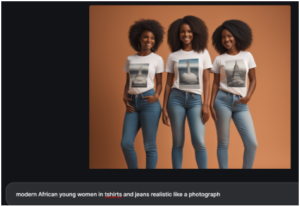
Another area that AI models seem to face a real challenge with is modern contexts for women in Africa. As stated earlier, Africa is a diverse continent and distinguishing African contexts can be a challenge. For example in some african countries, wearing african cloth and heavy african jewelry may be commonplace. It’s definitely not so common amongst young people in Kenya unless they are going to church or social functions like the ‘Blankets and Wines’ event in Kenya. The photos below were in response to a prompt requesting the AI application severally to generate images of young women at a seminar or conference somewhere in Kenya. The faces look realistic and kenyan enough but the dressing is oddly out of place for a seminar or conference.
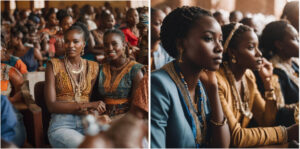
Another AI application generated the images below of women at a seminar. Again they all look similar in features, clothing and hairstyle. The image lacks that diversity so common and expected in a room full of African women who vary in so many ways from skin tone to hair styles to clothing. One might be in an african fabric dress and the next might be wearing the latest fashion. One might have blow dried hair, the other plaited hair and the third dreadlocks. The images above capture a bit of that vibrant and diverse context, but in the wrong situation. The second doesn’t.
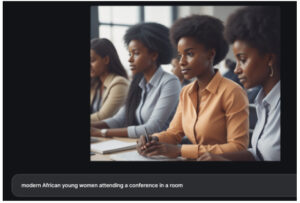
After varying the prompts again, I got the images below.

The list of AI struggles with African women is by no means exhaustive. I visited an AI application hosted by a royalty-free website hosting stock images. I thought their data set would give me better images and I was right. I did get better images as can be shown below.
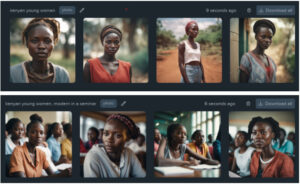
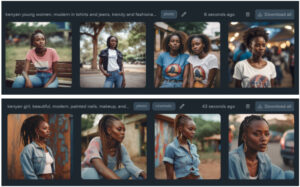
However, a number of other issues arose in this instance, such as the fact that AI struggles with hands and feet. The image below, culled from the ones shown earlier points to this fact. The woman portrayed in the image has three hands giving credence to the claim that AI struggles with hands and feet.
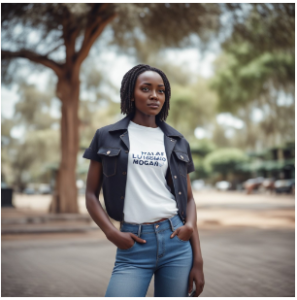
In the following image, one can also see that it is not quite clear if the woman is seated on the table or her thigh is somehow a part of the table. The table definitely seems to cut through her thigh. Or is it vice versa? At any rate, that table is clearly at varying levels between one thigh and the other.

Another AI application generated strange images of feet. As can be seen in the image below generated with the prompt ‘African girl sitting under an acacia tree reading a book at sunset,- facing the camera close up from the book towards her face with one hand holding the book.’ I even questioned if the leaves of the tree are similar to those of a real acacia tree. After all, the devil is in the details.


The strange feet in the images above made me prompt specifically for African feet. Not even asking for painted toe nails could generate anything better than what is shown below in this particular AI application.
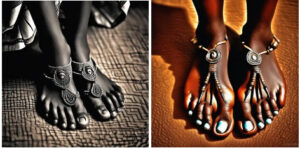
At least another AI application gave me better images (shown below) eliminating the feet and capturing a typical african girl, though I would have liked the girls to be wearing more modern clothing like T-shirts and Jeans and not a dress. At least that’s what I would wear, if I was sitting down under an acacia tree reading a book to avoid the ‘grass burn’ and insects.

The final thing that is common with all these photographs is the lack of diversity in facial expressions. Most of them portray people with solemn facial expressions. Only a few are smiling or expressing a different emotion.
To be fair with most of the challenges listed above, stock image websites also share some of the problems of AI and have a dearth of images of African women in a variety of contexts. This contributes to the limited and stereotypical datasets used to train AI models and results in the images above. So while AI promised a budding designer like me an easy source for African images, I may just have to take a proper course in design or hone my camera skills.

